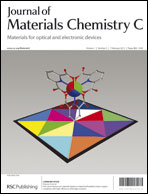Functionalization of molecular glasses: effect on the glass transition temperature†
Abstract
Molecular glasses constitute an appealing class of materials combining the advantages associated with small molecules with the potential to form glassy phases. However, the current design of functional molecular glasses is highly dependent on a trial and error approach. By achieving a better understanding of the microscopic behaviors that govern the propensity of a system to generate a glassy state, the glassy behavior of new molecules can be identified before their synthesis. Full-atomistic simulation is genuinely invaluable for achieving this goal. A series of functionalized


 Please wait while we load your content...
Please wait while we load your content...